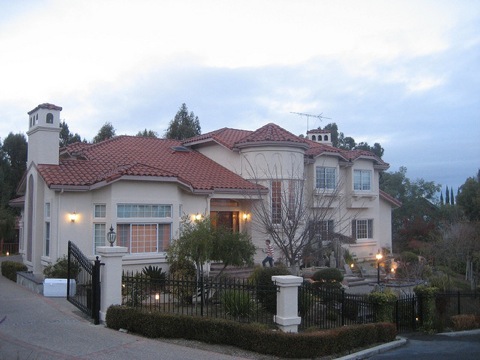In 2006, Jessy Kate Schingler and four other young engineers landed jobs at NASA’s Ames Research Center. They suddenly needed a place to live in Silicon Valley, but rather than opt for cheap housing with a long commute, they pooled their resources and rented a palatial 5,000 square foot property in Cupertino. The Rainbow Mansion was born.
It was more than just a luxury home full of brilliant young minds. Dubbed “an intentional community”, The Rainbow Mansion was an experiment in a new type of cohabitation. The house began hosting hackathons and salons in its library, inviting Silicon Valley’s best and brightest to participate. “Right away it set itself in motion,” Schingler says. “It had this sort of accidental mystique about it.”
In the six years since, the Rainbow Mansion has housed 60 people from 12 countries, along with employees from Google, Apple and Tesla. One of Schingler’s cofounders, Chris Kemp, became CTO of IT at NASA. And Schingler herself has become an advocate of coliving, the practice of bringing extraordinary people under one roof to live, work and change the world together.

The Rainbow Mansion. Photo by dweekly on Flickr.
In today’s America, almost 50 percent of adults in the United States are single, and more than a quarter of “households” are just an individual living alone. An increasing amount of social interaction happens online, rather than face-to-face.
Living alone may allow us to focus on our own goals without distraction, but it robs us of the type of communication that only happens when people are relaxed and at home together. The spaces between work and life — which, in decades past, would have been filled with conversations over the dinner table — are collapsing. Coliving hacks this trend, infusing the blurring boundaries of work and leisure with new opportunities for inspiration, learning, and social innovation.
Here, “home” is reinvented with a new purpose. It’s a community, an ethos, a series of opportunities for collaboration. And while most young professionals are flocking to urban centers like San Francisco to live in modest apartments, some are building a new American dream in once empty suburban McMansions and luxury downtown digs. In this new scheme, your network isn’t just your Facebook friends or business contacts; It includes your friends, influencers, ad hoc family, and your shared home.
Defining Coliving: What It Is and Isn’t
The underlying concept of coliving will be nothing new to anyone who’s had roommates: sharing a house, sharing the rent, living with near-strangers for a shared purpose. “Roommate situations are typically based on who can afford to pay the rent and who has one or two things in common,” says Chelsea Rustrum, an entrepreneur and coliving advocate. In a coliving home, the connections are stronger. Even if residents don’t know each other prior to moving in, “we have this vision in common of how we want to change the world,” she says.
Inspired entrepreneurialism is a central tenet. Residents are carefully chosen for their ambitions and ideas, and are often working on individual projects. “We want to be around people who want to make a difference,” says Schingler. But “making a difference” comes with infinite possibilities. Within a single house there may be scientists, artists, entrepreneurs, engineers and everything in between.
Coliving is influenced heavily by coworking, a practice in which independent professionals share a workspace rather than working individually at home. With no boss, no distractions and a building full of inspiring peers, synergy is the quick result of this separate-yet-together environment.

TheGlint residents at an ArtFlux event. Photo by Aurora Chiste.
Coliving spaces often include a coworking area. For example: TheGlint, a hilltop townhouse in San Francisco’s Twin Peaks, has a dedicated space furnished with desks and computers. But “it’s not just a live-in coworking space,” says TheGlint cofounder Damian Madray. He points to events like ArtFlux, a “participatory art experience” hosted in TheGlint’s gallery. Coliving houses regularly host events, from lectures to dance parties to hackathons, all designed to enhance creativity, professional development and good old-fashioned networking. Serendipity and collaboration abound.
The coliving movement may freely use terms like “commune” and “cooperative”, but this ain’t your grandma’s commune. Contemporary coliving builds on communal living practices, embracing a networked tech, business and science-fueled culture built upon innovation and realizing a better world through collaborative design.
Entrepreneurialism With a Conscience
"We never really stop working," says Damian Madray. “I don't think an entrepreneur life is like that — work and life — to be honest. You're always working and you're always playing. You're always playing because you love what you do.”
Madray, a young entrepreneur from Guyana, was inspired by his experience living Palo Alto’s Blackbox Mansion. In 2011, he and some friends aimed to create a similar community in Twin Peaks. Rustrum, inspired by her sojourn and research into Berlin’s Palomar5, joined the community early. “If you put the right people there, I think it has the potential to be very, very, very powerful,” she says.
But how to find those people? Schingler distills the issue into a challenge: cultivating “eliteness” without being exclusive. “How do you say, ‘I want people whom I consider elite around me, but I’m willing to keep myself open-minded enough to find that eliteness in unexpected places?’”
For many coliving spaces, the simplest solution is an opt-in one: A question for applicants to answer before they can be considered. TheGlint asks applicants to explain how they will “redefine heroism” with their work. Residents are carefully selected to feed the spirit of socially responsible innovation.
In a culture dominated by gadgets, it takes a little extra passion to come up with a business model that produces more than just profit. “What does Instagram do?” Madray asks. “It applies filters and makes you feel good. End of story. What if for every photo shared, some kid in Africa gets a glass of water? What if you apply some social good to it?”
Collaborative Inspiration

NASA Hackathon at Rainbow Mansion. Photo by alexandervandijk on Flickr.
When you’re living with a group of people, Rustrum says, “you’re a family whether you like it or not. That’s how we all relate to living together.”
Once the barriers of unfamiliarity begin to break down, people begin to work in harmony and think along similar lines. “You see through people's outer shell and into more of who they are,” says Rustrum. “You develop deeper, more real relationships and have the potential to actually work together, actually help each other. Not just in professional ways but in personal ways also.” This is the magic of coliving: It connects people in a multitude of ways, building trust and creating infinite opportunities for collaboration.
“It’s hard to explain the creative serendipity that goes on,” says Todd Huffman. He cites his own startup, which he runs out of the Langton Labs coliving space, as an example. His group is working to build a very advanced 3D microscope; it just so happens that four of his Langton roommates have PhDs relating to microscopy.
When a complex issue arises, he can simply walk down the hall and ask an expert.
The collaborative spirit created around the dinner table easily extends to computer desks and lab tables. Huffman describes Langton as “a commune with engineers instead of hippies.” A member of San Francisco’s arts-driven warehouse community with a population of scientists, artists, engineers and world travelers, Langton hosts events ranging from TEDx to dance parties to dorkbot, a celebration of “people doing strange things with electricity.”
Coliving spaces develop unique cultures based on the location and people chosen, their mission statement, and house activities. The underlying culture gives birth to serendipitous connections between residents who share similar values and passions.
Sharing the weight
From the ground up, the coliving movement is designed to offer stability, inspiration and opportunity to independent, ambitious young professionals — the backbone of tech startups, who are often expected to live on peanuts and take huge risks with little chance of reward.
“I find that a lot of startup stuff is like, ‘All right, you're just a lowly entrepreneur who hasn't made it yet. Therefore you deserve to live in dorms, in hostels, and compete in competitions and eat ramen and pizza.’ That's not my philosophy at all,” says Rustrum. “If you surround yourself with a nice place and decent healthy food, [you gain] the belief that you’re able to do whatever you want to do.”
Like coworking spaces, coliving houses capitalize on a shaky economy, locating in spaces that property managers can’t rent. In downtown San Francisco, warehouse communities like Langton Labs are re-appropriating vacant manufacturing spaces to offer residents private rooms and shared workspace for around $1,000 a month, highly affordable for the city.

Aurora Chiste and Damian Madray, of Italy and Guyana respectively, each bring an international perspective to their work in startups. Photo by Aurora Chiste.
An International Coliving Network
The coliving community is likely to continue growing quickly. With the success of Couchsurfing, AirBnB and global coworking networks like Loosecubes, the time may be right for a network of coliving houses around the globe.
For location-independent professionals and those who travel frequently, this is a fond dream: Imagine having a home wherever you go, well-appointed and populated by people you can truly enjoy. Imagine landing in a new city and having an extensive professional network already in place, or scooting off to another country for a month to work on a project in a new space. It’s all quite possible, and the concept of a coliving network is already in development.
Jessy Kate Schingler’s Embassy Network is preparing for an alpha run of houses in the fall of 2012. A membership model designed for both long-term residents and short-term travelers, the network will allow members to pay “rent” that gives them reservation access to any home in the network.
Chelsea Rustrum, inspired by the effectiveness of coworking and coliving as well as the power of travel, is spearheading a project called Startup Abroad. It’s designed to bring entrepreneurs outside their comfort zone and daily distractions for an intensive, two- to four-week experience. The first session is scheduled for August 2012 in Bali.
Damian Madray points out that an international network can help to inform innovators, helping them to look beyond first-world applications for their ideas. “If you solve a problem in a developing country, then those solutions can be applied to other developing countries,” he says. “Guess what? There are more developing countries than there are first world countries.”
Coliving’s Past and Future
ArtFlux – Presented by TheGlint by Michelle Primiani.
Coliving has clear similarities to traditional communes and co-ops. Langton Labs, in particular, bears a strong resemblance to 20th-century cooperative living. It has a flat organizational structure, and most decisions are made on a group email list. “In building a community, we didn't pick an existing model and emulate it,” says Todd Huffman. “We designed everything from the ground up, and in doing so, have ended up evolving in parallel and developing mechanisms that are very similar to cooperatives or communes.”
Unlike many prior communal living experiments, coliving spaces are externally oriented. They’re generally located in urban areas, often open to the public on a regular basis, and easy to move in and out of. The ideas brewing behind these doors are quickly realized and implemented in the world outside.
Much of this is related to the 21st-century vision of sharing, which allows for a high level of individualism and experimentation. Previous community models were focused on equality, with participants renouncing privileges to adopt a group-oriented mentality. In today’s open-source world, collaboration relies on contributions from a diverse pool of individuals, and welcomes exceptionality.
This phenomenon occurs across human culture: As our social organization has morphed from tight-knit groups to loose, technology-driven networks, we are supporting each other more and competing less. Sociologist Barry Wellman calls this networked individualism: our newfound ability to work together without losing sight of our internal goals.
Accordingly, the coliving movement seeks out exceptional people, asking them not to give themselves up to a single cause, but to support each other’s exceptionality. This may be the key to a new definition of “home,” one which provides comfort and friends along with inspiration and innovation.
As our social and professional landscapes shift, our concept of home is shifting too. By rebuilding their homes on a foundation of creative collaboration, coliving participants may next redefine the world by the same terms.









